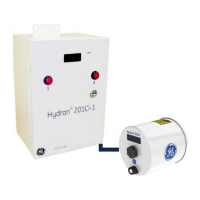alarm is triggered. The push-button’s alarm indicator is latched; in other words, it
remains on even if the alarm condition has disappeared and even if the alarm is
acknowledged (using the H201Ti’s keypad or the Hydran Host software). To turn it
off, you must press the corresponding push-button; an alarm indicator can only
be turned off if the alarm condition has disappeared during a period of time
exceeding the corresponding alarm delay (one of the alarm parameters).
6. Table 11-3 below lists the possible states of the Hydran 201Ci-1’s display and
alarm indicators.
Table 11-3: Possible States of the Hydran 201Ci-1’s Display and Alarm Indicators
7. During a fail alarm, the Hydran 201Ci-1’s display is blank (see Table 11-3 above),
and the analog outputs of the H201Ti and the H201Ci-1 drop to 4.00 ± 0.10 mA.
8. A message is recorded in the H201Ti’s History;Events file. Alarm messages are
thus stored in memory. The Events file can contain up to 500 messages. Each
message comes with a set of relevant parameters (gas level, trends, etc.) and is
identified with the recording date and time. For details, see Section 5.5.1.
11.4 Gas High and High-High Alarms
Parameters pertaining to gas High and High-High alarms are set in the Hydran
201Ti’s Gas submenu. For explanations on each parameter, see Section 5.5.2.
Set points for High alarms should be adjusted at values that indicate that the
transformer (or other equipment) requires closer monitoring. Set points for High-High
alarms should be adjusted at values considered as critical by the user, meaning that the
transformer requires immediate action; in general, this alarm implies an evaluation of the
equipment and its possible removal from service.
11.4.1 Alarm Parameters Setting
1.1.1.5 Gas Level
The gas level alarm uses the following parameters:

